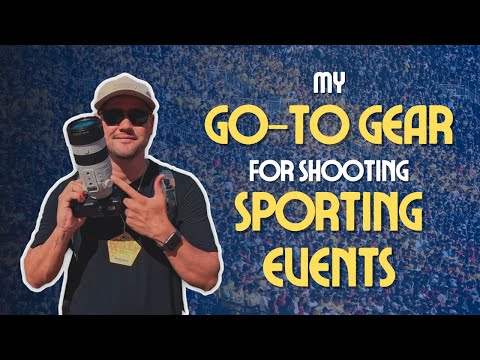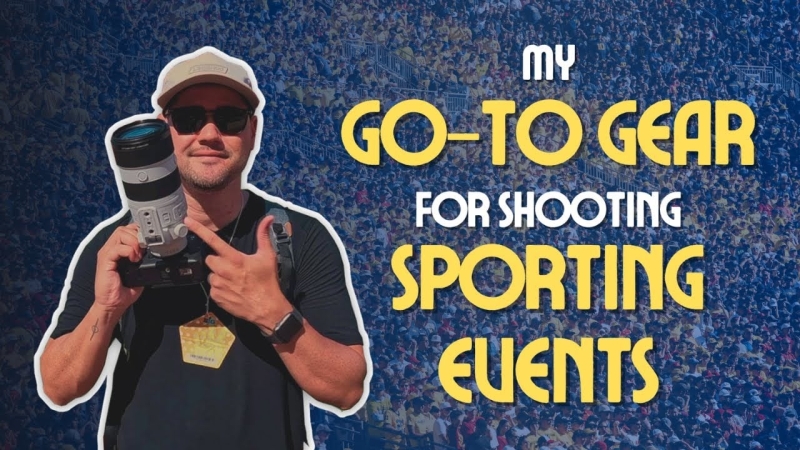Contents
For photographers looking to capture the fast-paced, high-energy world of college football, having the right gear and knowing how to take better sports photos can make all the difference. Of course, it’s not all about the gear, it’s also about knowing the best settings for sports photography and how to use the gear in the best way.
In this video from Adorama, seasoned sports photographer Brandon Dela Cruz shares his go-to equipment and practical tips for shooting stunning stills and video. Whether you’re a seasoned pro or just starting out, his insights will help you elevate your game while shooting the game!
The Camera: Sony A9III for Stills
Brandon’s camera of choice for stills is the Sony A9III, a camera he swears by for its global shutter. This feature eliminates warping or distortion caused by rolling shutter. This is crucial when shooting subjects moving at high speeds, like football players.
The global shutter allows him to shoot at high shutter speeds, ensuring crisp, sharp edges in every frame. When it comes to the best camera settings for football photography, Brandon recommends using a fast shutter speed (1/1000s or higher) to freeze the action, paired with a wide best aperture for sports photography, such as f/2.8, to ensure a shallow depth of field and beautiful background blur.
One of the standout features of the A9III is its ability to shoot at 120 frames per second, ensuring he never misses a moment. The pre-capture mode is another game-changer. If a player is sprinting for a touchdown and Brandon switches from video to photo mode, the camera captures a few frames before he even presses the shutter button. This feature has saved him more than once, especially when experimenting with how to take better sports photos by anticipating the action.
The Lens: Sony 70-200mm f/2.8 G Master
Paired with the A9III, Brandon uses the Sony 70-200mm f/2.8 G Master Mark I. He prefers this focal length because it strikes the perfect balance between zoom and flexibility. Shooting around the 135mm to 200mm range allows him to get close enough to the action while still having the option to capture wider shots. If needed, he can always crop in post-production. For those wondering about the best aperture for sports photography, Brandon sticks to f/2.8 to ensure fast autofocus and excellent low-light performance, which is essential for night games or indoor stadiums.
For sports photography, Brandon recommends shooting in H+ burst mode, the fastest setting on the A9III. With everything happening so quickly on the field, this mode gives him peace of mind, knowing he’ll capture the decisive moment. This is a key tip for anyone looking to master the best camera settings for football photography—burst mode ensures you never miss a split-second play.
Memory Cards: Speed Matters
With the A9III’s high-speed capabilities, fast memory cards are essential. Brandon uses Lexar CF Express Type A cards with a write speed of 800 MB/s. These cards keep up with the camera’s rapid-fire shooting, ensuring he never misses a shot. He also takes advantage of the dual card slots, using two 320GB cards for ample storage.
Switching Between Photo and Video
One of Brandon’s favourite features of the A9III is its seamless ability to toggle between photo and video modes. He often shoots video in 4K at 120 frames per second, which delivers buttery-smooth slow-motion footage. The transition between modes takes less than a second, making it ideal for capturing both stills and video during a game.
The Sony FX3 for Video
When video is the primary focus, Brandon turns to the Sony FX3. This compact yet powerful camera is a beast in low-light conditions, thanks to its dual native ISO of 800 and 12,800. For night games, he keeps the ISO at 12,800 to maintain brightness and clarity.
Another standout feature is the FX3’s in-body stabilization. Brandon typically shoots in active mode, which provides extra stabilization at the cost of a slight crop. He rigs out the FX3 with a Smallrig cage, side handle, and top handle, attaching an Atomos Shinobi monitor for better framing and focus.
To capture crowd noise and ambient sound, Brandon uses a Rode shotgun mic. Despite its small size, it delivers surprisingly high-quality audio, adding depth to his video footage.
Brandon’s Tips for Aspiring Sports Photographers
- Plan for the Elements: A water-resistant backpack ensures your gear stays safe in unpredictable weather.
- Master Your Camera Settings: Familiarize yourself with burst modes, pre-capture features, and toggling between photo and video.
- Choose the Right Lens: A 70-200mm lens offers versatility for both close-ups and wider shots.
- Invest in Fast Memory Cards: High-speed cards are essential for capturing rapid-fire action.
- Stabilize Your Shots: Use in-body stabilization or rigs to keep your footage smooth, especially in low light.
- Capture Audio: Don’t overlook the importance of sound. A good shotgun mic can elevate your video content.
Photographing college football is as much about preparation as it is about skill. By investing in the right gear and mastering its features, you can capture the intensity and emotion of the game. Brandon’s setup—centred around the Sony A9III and FX3—offers a perfect blend of speed, versatility, and quality. Obviously you don’t need to switch to Sony, but his gear gives you an idea of what’s necessary.
Whether you’re shooting stills, video, or behind-the-scenes content, these tools and tips will help you tell the story of the game in a way that’s both dynamic and unforgettable.
Check out the full video below:


